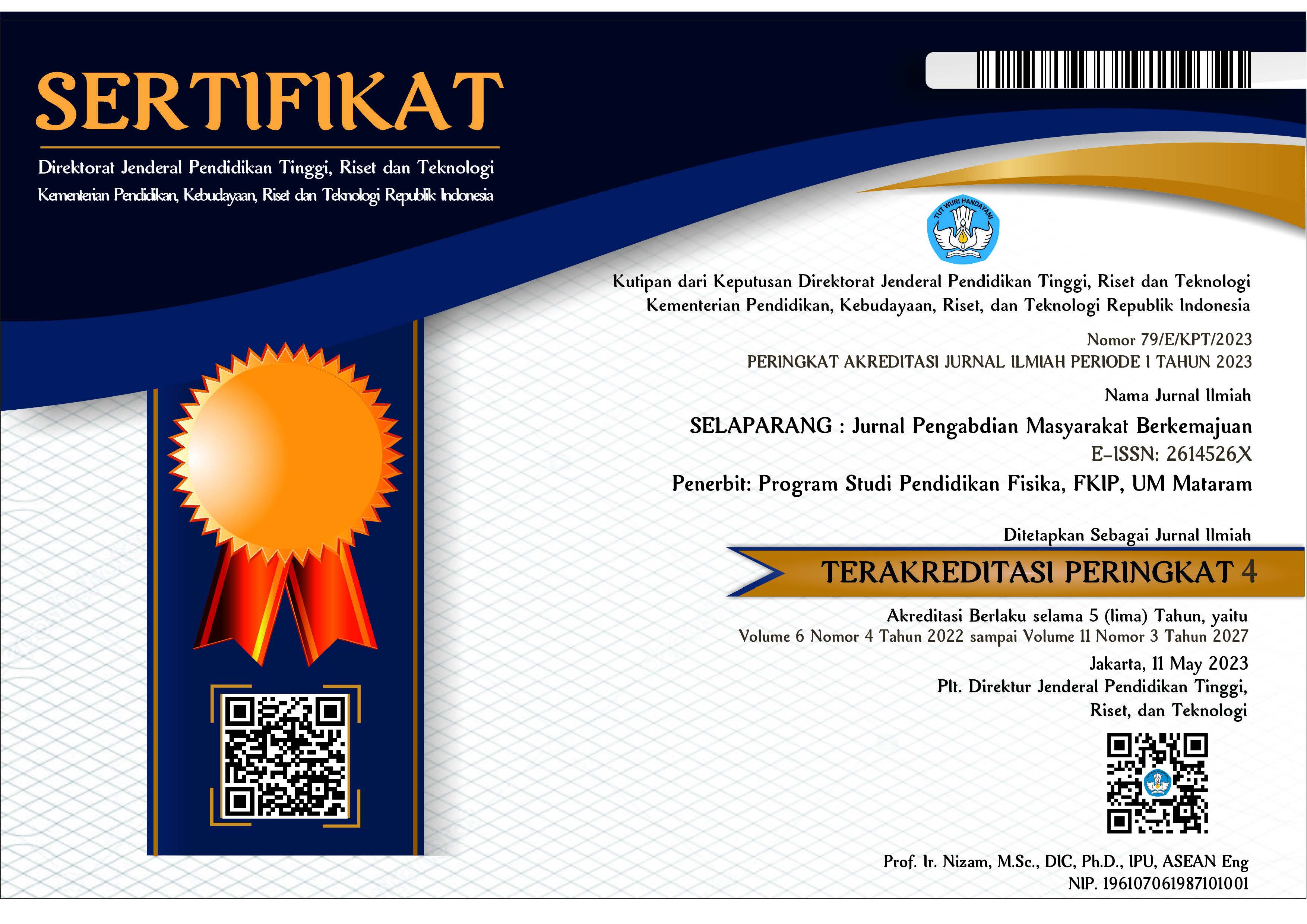OPTIMASI POPULASI SAPI BALI BETINA UNGGUL MELALUI INSEMINASI BUATAN DAN SOSIALISASI DI KOPERASI PETERNEKAN 'TUNAS RIDHO ILAHI' DI PULAU LOMBOK, NTB DENGAN STRAW SEXING
Abstract
ABSTRAK
Penelitian ini bertujuan untuk meningkatkan populasi dan kualitas sapi Bali betina unggul di Koperasi Peternakan "Tunas Ridho Illahi," Kabupaten Lombok Timur, NTB. Koperasi ini menjadi wadah bagi peternak sapi potong dengan fokus pada budidaya Sapi Bali, yang memiliki makna kultural dan genetik di Pulau Lombok. Meskipun diakui sebagai Plasma Nuftah Indonesia, produktivitas sapi Bali belum optimal disebabkan oleh kualitas bibit yang buruk. Solusi diusulkan melalui sosialisasi dan pelaksanaan inseminasi buatan dengan bibit sapi Bali betina unggul, dengan kolaborasi antara dosen Universitas Mataram dan koperasi. Metode melibatkan koordinasi awal, sosialisasi, dan pelaksanaan inseminasi buatan. Koordinasi awal membangun pemahaman tentang masalah dan rencana kerja. Sosialisasi mengedukasi tentang pemilihan sapi betina unggul dan inseminasi buatan. Langkah ini diharapkan meningkatkan produktivitas dan kualitas ternak. Hasilnya menunjukkan kolaborasi sukses dalam mengatasi kendala, memulai perbaikan kualitas genetik sapi Bali betina unggul. Melalui diskusi, presentasi, dan partisipasi peternak, sosialisasi efektif menginformasikan dan memotivasi. Kegiatan ini menciptakan kesadaran dan keterlibatan aktif komunitas peternak. Pelatihan praktis memberi panduan tentang persiapan sapi betina untuk inseminasi buatan. Meskipun tahap inseminasi belum terlaksana, pendekatan kolaboratif ini diharapkan memberikan dampak positif dalam mengembangkan sektor peternakan di wilayah ini.
Kata kunci: sapi bali betina unggul; inseminasi buatan; sosialisasi; kolaborasi; produktivitas ternak
ABSTRACT
This study aims to increase the population and quality of superior female Bali cattle in the Animal Husbandry Cooperative "Tunas Ridho Illahi," East Lombok Regency, NTB. This cooperative is a forum for beef cattle breeders with a focus on the cultivation of Bali cattle, which has cultural and genetic significance on the island of Lombok. Even though it is recognized as Indonesian Nuftah Plasma, the productivity of Bali cattle is not optimal due to the poor quality of the breed. The solution was proposed through socialization and implementation of artificial insemination with superior female Bali cattle, in collaboration between Mataram University lecturers and cooperatives. The method involves initial coordination, socialization, and implementation of artificial insemination. Initial coordination builds understanding of the problem and work plan. Socialization educates about the selection of superior female cows and artificial insemination. This step is expected to increase the productivity and quality of livestock. The results show a successful collaboration in overcoming obstacles, starting to improve the genetic quality of superior female Bali cattle. Through discussions, presentations, and farmer participation, socialization effectively informs and motivates. This activity creates awareness and active involvement of the farming community. Practical training provides guidance on preparing cows for artificial insemination. Although the insemination stage has not yet been carried out, this collaborative approach is expected to have a positive impact on developing the livestock sector in this region.
Keywords: superior female bali cattle; artificial insemination; collaboration; livestock productivity
Keywords
Full Text:
PDFReferences
Asnawati, N., Jayadi, M., Afrilia, S., Sofyandi, M., Wahyuni, S., Hayati, J., … Unsunnidhal, L. (2021). EDUKASI MUSNAHKAN GIZI BURUK DI DESA MENGGALA, KABUPATEN LOMBOK UTARA, PROVINSI NUSA TENGGARA BARAT (DAERAH TERTINGGAL) MELALUI TERAPI MERDEKA MADU TRIGONA. SELAPARANG. Jurnal Pengabdian Masyarakat Berkemajuan, 5(1), 301–305.
Fathurrahman, I., Kusumawati, A., Rahman, A., Ulviani, Y., Prihantoko, K. D., & Unsunnidhal, L. (2022). Molecular sexing in Bos taurus using quantitative polymerase chain reaction (qPCR) method. IOP Conference Series: Earth and Environmental Science, 976(1). https://doi.org/10.1088/1755-1315/976/1/012002
If’all, Unsunnidhal, L., & Hakim, I. (2023). Tumbuh Bersama: Mendukung Pertanian Lokal, Ketahanan Pangan, Kelestarian Lingkungan, dan Pengembangan Masyarakat. Jurnal Pengabdian West Science, 2(5), 364–373. https://doi.org/10.58812/jpws.v2i5.376
Ishak, J., Unsunnidhal, L., Martien, R., & Kusumawati, A. (2019). In vitro evaluation of chitosan-DNA plasmid complex encoding Jembrana disease virus Env-TM protein as a vaccine candidate. Journal of Veterinary Research, 63(1), 7–16. https://doi.org/https://doi.org/10.2478/jvetres-2019-0018
Kusumawati, A., Satrio, F. A., Indriastuti, R., Rosyada, Z. N. A., Pardede, B. P., Agil, M., & Purwantara, B. (2023). Sperm Head Morphology Alterations Associated with Chromatin Instability and Lack of Protamine Abundance in Frozen-Thawed Sperm of Indonesian Local Bulls. Animals, 13, 1–13. https://doi.org/https://doi.org/10.3390/ani13152433
Pardede, B. P., Kusumawati, A., Pangestu, M., & Purwantara, B. (2023). Bovine sperm HSP-70 molecules : a potential cryo-tolerance marker associated with semen quality and fertility rate. Frontiers in Veterinary Science, 10(August), 1–10. https://doi.org/10.3389/fvets.2023.1167594
Rahman, A., Kusumawati, A., Budiyanto, A., Ulviani, Y., Fathurrahman, I., Prihantoko, K. D., & Unsunnidhal, L. (2022). Molecular Verification of Sex-separated Straw of Simmental Cattle ( Bos taurus ) by Polymerase Chain Reaction (PCR) . Proceedings of the 9th International Seminar on Tropical Animal Production (ISTAP 2021), 18(Istap 2021), 223–226. https://doi.org/10.2991/absr.k.220207.046
Unsunnidhal, L., & Suryawati, B. N. (2020). Penguatan Ekonomi Masyarakat Pasca Bencana Gempa melalui Pendampingan Pembuatan Usaha Rumahan di Pemenang Barat. Selaparang. Jurnal Pengabdian Masyarakat Berkemajuan, 3(2), 166–169.
Unsunnidhal, L, Ishak, J., & Kusumawati, A. (2019). Expression of gag-CA Gene of Jembrana Disease Virus with Cationic Liposomes and Chitosan Nanoparticle Delivery Systems as DNA Vaccine Candidates. Tropical Life Sciences Research, 30(3), 15–36. https://doi.org/https://doi.org/10.21315/tlsr2019.30.3.2
Unsunnidhal, Lalu, & Dwi Prihantoko, Kurniawan Kusumawati, A. (2021). PENYULUHAN PERILAKU SEHAT, EDUKASI PENTINGNYA MANAJEMEN KESEHATAN REPRODUKSI TERNAK POTONG DAN PENYERAHAN BANTUAN SEMBAKO COVID-19 DI KELOMPOK TERNAK SAPI POTONG “KALIMASODO”, KARANGDUKUH, JOGONALAN, KLATEN, JAWA TENGAH. Lentera Jurnal. Jurnal Pengabdian, 1(1), 15–23. https://doi.org/10.26714/.......................p-ISSN
Unsunnidhal, Lalu, Dwi Prihantoko, K., & Kusumawati, A. (2021). EDUKASI PENTINGNYA MANAJEMEN KESEHATAN REPRODUKSI TERNAK POTONG DAN PENYERAHAN BANTUAN SEMBAKO COVID-19 DI KELOMPOK TERNAK SAPI POTONG “KALIMASODO”, KARANGDUKUH, JOGONALAN, KLATEN, JAWA TENGAH. SELAPARANG. Jurnal Pengabdian Masyarakat Berkemajuan, 4(April), 23–27.
Unsunnidhal, Lalu, & Suryawati, B. N. (2020). Analisis Risiko Usaha Ternak Di Dusun Koloh Brora Dan Pengenalan Upaya Mitigasi Risiko Melalui Diversifikasi Usaha. Sasambo: Jurnal Abdimas (Journal of Community Service), 2(2), 64–69.
Unsunnidhal, Lalu, Wasito, R., Nugraha Setyawan, E. M., Warsani, Z., & Kusumawati, A. (2021). Potential of polylactic-co-glycolic acid (PLGA) for delivery Jembrana disease DNA vaccine Model (pEGFP-C1-tat). Journal of Veterinary Science, 22(6), 1–15. https://doi.org/10.4142/jvs.2021.22.e76
Unsunnidhal, Lalu, Wasito, R., Setyawan, E. M. N., & Kusumawati, A. (2021). Potential of Nanoparticles Chitosan for Delivery pcDNA3.1-tat. BIO Web of Conferences, 41(07004), 1–6.
DOI: https://doi.org/10.31764/jpmb.v7i4.19332
Refbacks
- There are currently no refbacks.

This work is licensed under a Creative Commons Attribution-ShareAlike 4.0 International License.
______________________________________________________
Jurnal Selaparang
p-ISSN 2614-5251 || e-ISSN 2614-526X
EDITORIAL OFFICE:



















